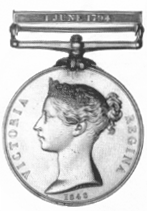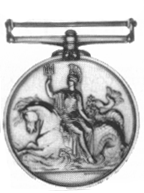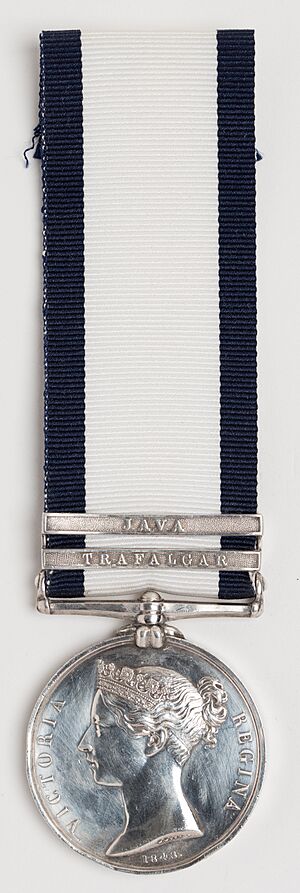Naval General Service Medal (1847) facts for kids
The Naval General Service Medal (often called the NGSM) was a special award given to sailors and officers of the Royal Navy. It was approved in 1847 and first given out in 1849. This medal was for naval actions that happened between 1793 and 1840. This time included major conflicts like the French Revolutionary Wars, the Napoleonic Wars, and the War of 1812 against America.
The NGSM was one of the first British medals given to all ranks for fighting in battles. It was similar to the Military General Service Medal given to soldiers.
Who Received the Medal?
This medal was only given to people who were still alive and applied for it. Many sailors did not apply. This was sometimes because they couldn't read or didn't know about the medal. If someone applied but died before getting the medal, their family would receive it.
Because the medal was awarded so long after the battles, fewer medals were given out than expected. For some battles, only a few people claimed their medal. There were even ten battles for which no one applied at all!
Two men, Sir John Hindmarsh and Admiral Sir James Gordon, received medals with seven clasps. This was the most given to any single person. Four men earned six clasps, and fourteen earned five.
A unique case was Daniel Tremendous McKenzie. He was born on a ship, HMS Tremendous, during the Glorious First of June battle. He applied for and received the medal with the '1 June 1794' clasp. Another interesting story was Jane Townshend, a woman on HMS Defiance during the Battle of Trafalgar. Her application was first approved, but then denied. This might have been to avoid setting a rule for other women to claim medals.
About 126 medals were given to soldiers from the British Army. These soldiers were on Royal Navy ships during qualifying battles. The Admiralty gave out 20,933 medals in total. Most of these, 15,577, were given to people who received only one clasp.
What the Medal Looked Like
The medal was designed by William Wyon. It was made of silver and was about 3.6 centimeters (1.4 inches) wide.
- Front (Obverse): It showed a picture of Queen Victoria facing left. Around her, it said "VICTORIA REGINA" (Queen Victoria) and the date “1848”.
- Back (Reverse): This side showed Britannia, a symbol of Britain. She was holding a trident and sitting on a seahorse.
- Naming: The name of the person who received the medal was carved into its edge. For officers, their rank was also included.
- Ribbon: The ribbon was about 3.2 centimeters (1.25 inches) wide. It was white with dark blue edges. This design was based on the ribbon used for the Naval Gold Medal.
Clasps: Showing Each Battle
A "clasp" is a small bar attached to the medal's ribbon. Each clasp represented a specific battle or action. If a sailor fought in many battles, they would have many clasps on their medal. In total, 231 different clasps were approved. This included 176 for specific battles and 55 for "Boat Service." Boat Service meant fighting in small boats, like when sailors boarded enemy ships or attacked targets on shore.
Here are some famous battles that earned clasps:
French Revolutionary Wars (1793–1802)
This period saw many naval battles between Britain and France. Some notable clasps from this time include:
- 1 June 1794: For the Glorious First of June, a major fleet battle.
- St. Vincent: For the Battle of Cape St Vincent (1797), where Britain fought Spain.
- Camperdown: For the Battle of Camperdown, a big fight against the Dutch navy.
- Nile: For the famous Battle of the Nile, where Admiral Nelson defeated the French fleet.
- Copenhagen: For the Battle of Copenhagen (1801), where Britain fought Denmark-Norway.
Napoleonic Wars (1803–1815)
These wars were a huge conflict across Europe, with many important naval battles.
- Trafalgar: This is one of the most famous clasps, for the Battle of Trafalgar in 1805. Here, Admiral Nelson won a huge victory against France and Spain.
- St. Domingo: For the Battle of San Domingo in 1806.
- Martinique: For the Invasion of Martinique (1809).
- Java: For the Invasion of Java (1811).
- Lissa: For the Battle of Lissa (1811) in the Adriatic Sea.
War of 1812 (1812–1815)
This war was fought between the United States and Great Britain.
- Shannon Wh. Chesapeake: For the battle between HMS Shannon and USS Chesapeake in 1813.
- Pelican 14 Augt. 1813: For the capture of USS Argus by HMS Pelican.
- Phoebe 28 March 1814: For the capture of USS Essex by HMS Phoebe.
Later Battles or Actions
The medal also covered some actions that happened after the major wars.
- Algiers: For the Bombardment of Algiers (1816), where British and Dutch ships attacked Algiers.
- Navarino: For the Battle of Navarino in 1827, where Britain, France, and Russia fought the Ottoman Empire.
- Syria: This is the most common clasp, with almost 7,000 issued. It was for the Syrian War in 1840.




